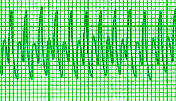Biology 304
Cardiac Muscle Lab
The chart speed is 0.1 cm/s
throughout.

Ionic Tests
How can you use the two cardiac action
potentials to explain the following results?
Sodium -
generally gives rise to an increased heart rate...why? ![]()

Calcium What
is the source of calcium for the heart cells? ![]()
![]()

Pharmacological Tests
Compare the results here with what you found
in the smooth muscle labs.
Acetylcholine
followed by Atropine - the
ACh effect is an extreme one. ![]()
Eserine and
Insecticide both showed effects similar to ACh. Why?
Temperature Effects
Series of temperature experiments can be
found at this page.
Thanks to
all who contributed their data!
|
R.F. Lauff Department
of Biology |



